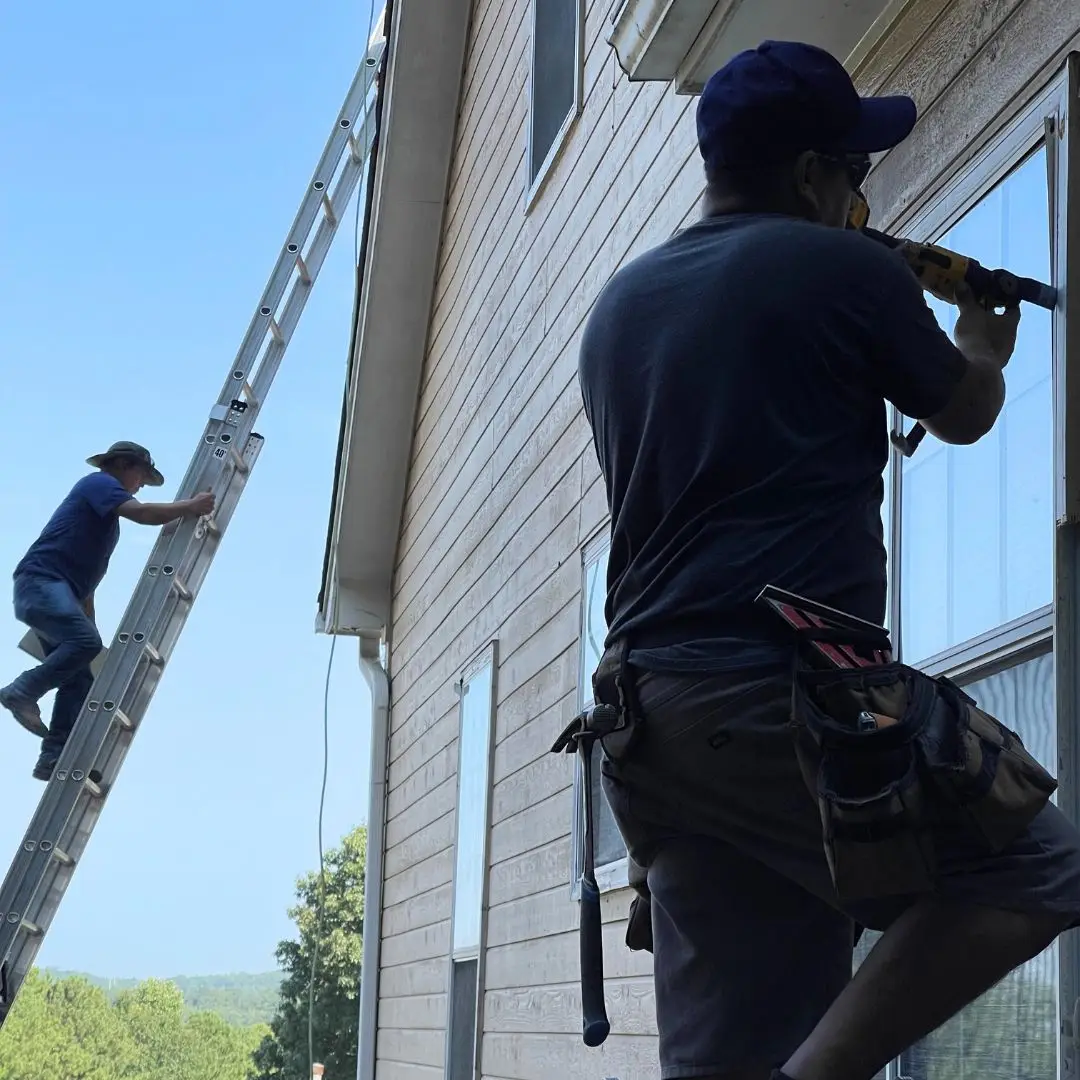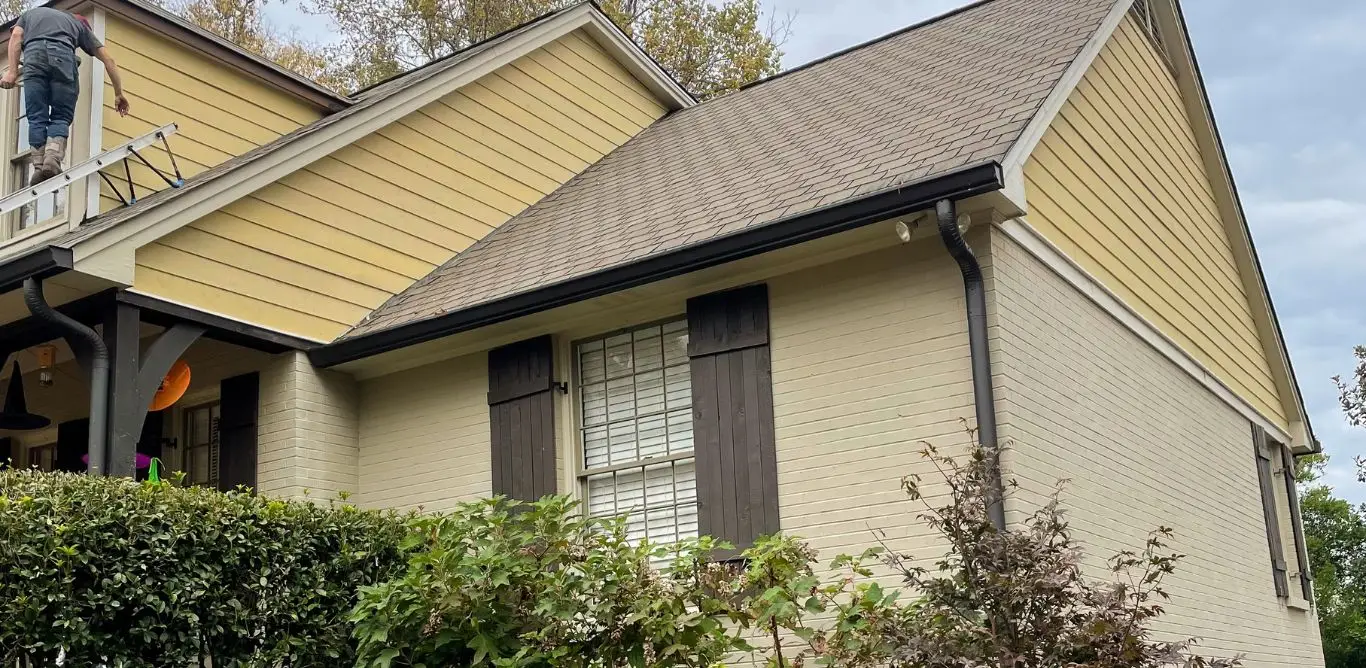Home Renovations & Exterior Repairs
Home Renovations & Exterior Repairs
Choosing the right siding for your home can feel overwhelming with so many options on the market. Whether you’re a first-time homeowner or a seasoned pro, it’s important to know the pros and cons of each siding type to make an informed decision. This guide breaks down the most popular options to help you find the perfect balance between durability, aesthetics, and budget—plus, we’ll highlight one siding you’ll want to avoid.
Last Updated 3/31/2025 | Siding

It is made from a mixture of cement, sand, and cellulose fibers that are compressed together.
Our team installs fiber cement siding more often than anything else—and for good reason. I believe in it because I’ve seen firsthand how well it performs compared to other materials. It’s strong and durable. Unlike other types of siding that tend to rot, attract and harbor pests, or hide major water damage until it’s too late, fiber cement holds up in just about any condition.

Both cedar lap siding and cedar shake siding have been a go-to for homeowners who want a timeless, natural look. It brings character to any home, whether you’re aiming for a rustic cabin feel or classic coastal charm. I’ve worked on plenty of houses in Hoover, AL, with cedar shake, and there’s nothing quite like the rich texture and deep color of real cedar on a home. If you’re considering cedar shake siding, here’s what you need to know about its strengths and challenges.

Plywood siding has been a staple in home construction for decades because it’s affordable, easy to install, and structurally strong. I’ve seen it used on everything from small backyard sheds to full-sized homes, and when properly maintained, it holds up surprisingly well.
There are plenty of sizes to choose from, including 12-inch OC Channel, 8-inch OC Channel, and 4-inch OC Channel. If you’re looking for a budget-friendly siding option that’s straightforward to work with, plywood siding might be the way to go. But before you commit, here’s what you should know about its pros and cons.

If you’ve ever driven through an older neighborhood and admired the classic, overlapping wood siding, chances are you were looking at pattern 105 siding—though you might know it by another name. It’s also called Dutch lap, German lap, drop siding, or cove lap, depending on where you are and who you’re talking to. No matter the name, this siding goes way back because it has been a staple in American home construction for well over a century.
I’ve worked on plenty of homes with it, and when properly maintained, it can last for generations. If you love that traditional, craftsman-style look, pattern 105 siding is worth considering. Let’s go over the pros and cons before you decide if it’s the right fit for your home.

Smart Siding, also known as LP® SmartSide®, is a type of engineered wood siding made from oriented strand board (OSB) that has been treated with a proprietary blend of resins, waxes, and zinc borate for added durability. It’s designed to mimic the look of traditional wood siding but with improved resistance to moisture, pests, and impact damage.
According to their Wiki page, LP has been manufacturing SmartSide since 1997 and claims to have had no warranty claims for fungal decay on this product. However, this wasn’t always the case. Their previous product line, Inner-Seal siding, faced significant issues in the 1990s, leading to a major class-action lawsuit. Many homeowners reported premature rotting, discoloration, and fungal growth, which resulted in LP paying nearly $1 billion in settlements. Since then, LP has re-engineered its siding, and SmartSide has been on the market for over 25 years with no reported warranty claims for fungal decay.
Vinyl siding is the cheapest option on the market, which is why so many homeowners go for it. But after 25 years of repairing siding, I’ve seen the hidden dangers vinyl can create.
Time after time, I remove vinyl siding from a house only to find major water damage and even structural rot underneath—damage the homeowners had no idea was happening. The problem? Vinyl is basically plastic. Unlike wood or fiber cement, it doesn’t show any signs of water intrusion on the surface. Water gets in, sits there, and slowly destroys everything behind it while the outside still looks fine. If you’re considering vinyl siding, here’s what you need to know before making your decision.

I’ve seen metal siding installed on a number of new homes recently, especially on barndominiums and modern industrial-style builds. In my opinion, it’s the most durable siding option out there. While metal has been around for a long time, it’s mainly been used on roofs and commercial buildings, Now, it’s becoming more popular for residential construction. It offers excellent weather resistance and a distinct aesthetic, but like any material, it comes with its pros and cons. If you’re considering metal siding for your home, here’s what you need to know.
If you want the best material out there, brick is it. We’ve been using brick since the beginning of time, and for good reason—it’s durable, fireproof, low-maintenance, a great insulator, and lasts for centuries. Even the Three Little Pigs reached a consensus that brick was the only way to go! Whether you’re going for a classic, timeless look or just want a home that can stand up to anything, brick is hard to beat. In my opinion, it’s the best option available—let’s break down why, along with a few things to consider before making your decision.

I love the look of ledge stone. It gives homes a high-end, natural appearance without the heavy, gothic feel of full-stone construction. Compared to stacked stone, ledge stone is much easier to install, making it a great choice for adding texture and depth to a home’s exterior. I’ve noticed it’s especially popular in places like Colorado and Utah, where it’s common to see ledge stone along the first 4 feet of a home’s exterior before transitioning into Hardie lap siding. If you’re considering ledge stone for your home, here’s what you need to know.

Masonite siding is another popular form of siding but has been discontinued. If you have masonite siding it’s important that you keep it caulked and painted to prevent deterioration. If it’s already rotting and swelling you should consider replacing your siding. If you’re unsure about the state of your masonite siding, contact an expert for an inspection to understand what your next steps should be.
Homebuyers, beware! If you’re considering purchasing a home with Masonite siding, proceed with caution. Masonite has a well-documented history of moisture problems, leading to rot, swelling, and structural damage. What may seem like a minor issue on the surface can quickly become a costly headache. Always have a professional inspect the siding before making an offer. In most cases, replacing Masonite is the best long-term solution to protect your investment.
If you have Masonite siding or are thinking about buying a home with it, check out my comprehensive guide to learn how to spot the common types of Masonite, the potential issues, and what you can do to protect your home. Masonite Discontinued Their Siding, Now What?

If you’re looking for the cheapest siding option, vinyl is the clear budget winner. It’s widely available, easy to install, and doesn’t require much maintenance. That’s why so many homeowners choose it when cost is their main concern. However, after years of repairing siding, I’ve seen firsthand how vinyl can hide serious issues—like moisture damage and structural rot. What seems like an affordable upgrade can turn into a nightmare when it’s time to sell.
Most people who install vinyl siding say they’ll be moving in a few years anyway. My advice? Move sooner rather than later. The last thing you want is for a home inspector to uncover major water damage right before closing. At that point, you’ll either be paying for repairs again, offering the buyer a discount to cover the damage, or worse—watching them walk away in favor of a home that’s been properly maintained.
If budget is your top priority, vinyl will get the job done—just know what you’re signing up for before making the call.
The type of siding that is right for you will depend on several factors, including a budget, climate, style preference, and the condition of your home’s existing siding. Options include vinyl, wood, aluminum, fiber cement, stone veneer, and many more. Choosing the right siding for your home can be a difficult decision and it is recommended that you speak with an experienced contractor to discuss all of your options.
Metal sidings are more durable, fire resistant, easy to maintain, and recyclable. In addition, insects don’t attack metal bodies. So, it is safe from insects as well. Most people like metal siding for low maintenance. You also can choose Metal siding for these qualities.
It depends on your choices. If you want an earthy appeal to your home, you can choose materials made from clay and wood. On the other hand, stainless steel, aluminum, and corrugated metal are the best for a modernist touch.
Yes, there are different types of vinyl siding. The most common types are wood grain, board, batten, dutch lap, traditional lap, cedar shake, hand split shake, traditional shake, half round, etc. So, you have plenty of options to choose from.
If reading about different siding options has you realizing it’s time for a repair or replacement, we’re here to help. At Home Repair Service, we specialize in siding replacements that stand the test of time. Whether you need a quick repair or a full siding upgrade, we’ll help you find the best option for your home and budget. Check out our siding services to see if we’re the right fit for your project!
Helpful Links